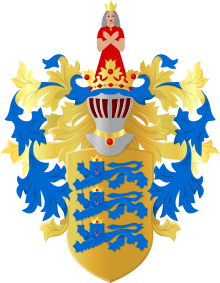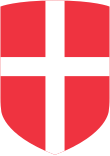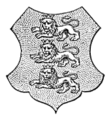
Three Crowns is the national emblem of Sweden, present in the coat of arms of Sweden, and composed of three yellow or gilded coronets ordered two above and one below, placed on a blue background. Similar designs are found on a number of other coats of arms or flags.

The coat of arms of Belgium bears a lion or, known as Leo Belgicus, as its charge. This is in accordance with article 193 of the Belgian Constitution: The Belgian nation takes red, yellow and black as colours, and as state coat of arms the Belgian lion with the motto UNITY MAKES STRENGTH. A royal decree of 17 March 1837 determines the achievement to be used in the greater and the lesser version, respectively.

The coat of arms of Bulgaria consists of a crowned golden lion rampant over a dark red shield; above the shield is the Bulgarian historical crown. The shield is supported by two crowned golden lions rampant; below the shield there is compartment in the shape of oak twigs and white bands with the national motto "Unity makes strength" inscribed on them.

The coat of arms of Ukraine is a blue shield with a golden trident. Officially referred to as the Emblem of the Royal State of Volodymyr the Great, or, colloquially, the tryzub, the insignia derives from the seal-trident of the Grand Dukes of Rus.

The coat of arms of Estonia is a golden shield which includes a picture of three left-facing blue lions with red tongues in the middle, with golden oak branches placed on both sides of the shield. The insignia derive(s) from the coat of arms of Denmark, which ruled northern Estonia in the 13th-14th centuries and parts of western Estonia in the 16th-17th century.

The coat of arms of Romania was adopted in the Romanian Parliament on 10 September 1992 as a representative coat of arms for Romania. The current coat of arms is based on the lesser coat of arms of interwar Kingdom of Romania, which was designed in 1921 by the Transylvanian Hungarian heraldist József Sebestyén from Cluj, at the request of King Ferdinand I of Romania, it was redesigned by Victor Dima. As a central element, it shows a golden aquila holding a cross in its beak, and a mace and a sword in its claws. It also consists of the three colors which represent the colors of the national flag. The coat of arms was augmented on 11 July 2016 to add a representation of the Steel Crown of Romania.

The coat of arms of Russia derives from the earlier coat of arms of the Russian Empire. Though modified more than once since the reign of Ivan III (1462–1505), the current coat of arms is directly derived from its medieval original, with the double-headed eagle having Byzantine and earlier antecedents. The general tincture corresponds to the fifteenth-century standard.

The coat of arms of Malta is the national coat of arms of the country of Malta.

The coat of arms of Montenegro was officially adopted by the law passed in the Parliament on 12 July 2004. It is now the central motif of the flag of Montenegro, as well as the coat of arms of the Armed Forces of Montenegro. It was constitutionally sanctioned by the Constitution proclaimed on 2 October 2007.

The coat of arms of Denmark has a lesser and a greater version.
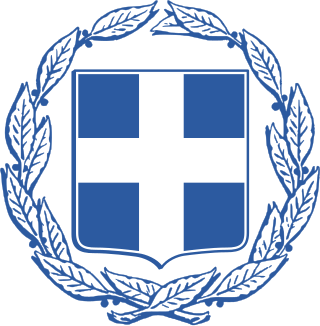
The coat of arms of Greece or national seal of Greece comprises a white Greek cross on a blue escutcheon, surrounded by two laurel branches. It has been in use in its current form since 1975. Prior to the adoption of the current coat of arms, Greece used a number of different designs, some of which were not heraldic; the first heraldic design was introduced in 1832 and its main element, the blue shield with the white cross, has been the base for all other national coats of arms since then. The design is a heraldic representation of the Greek national flag adopted in 1822, which featured a white cross on a blue field.

The official coat of arms of Grenada is a shield divided into four parts by a golden cross. In the centre of this cross is the Santa Maria, Columbus' flagship. A lion passant guardant on a red field is shown in the upper left and lower right sections of the shield, with a golden crescent moon out of which a lily grows in the upper right and lower left sections. Above the shield there is a golden helmet, topped with a garland of bougainvillea branches. Within the garland are seven red roses, which stand for the seven communities of Grenada. Holding the shield on the dexter side is a nine-banded armadillo which stands before a corn stalk; on the sinister side is a Grenada dove, which stands before a banana plant. The base represents Mount St. Catherine with the Grand Etang Lake at the centre. A ribbon displays the national motto: "Ever conscious of God we aspire, build and advance as one people."

The coat of arms that serves as the symbol of the Lublin Voivodeship, Poland depicts a white (silver) male jumping cervus (deer), with a yellow (golden) crown on its neck, placed on a red background. The current design of the coat of arms was designed by Andrzej Heidrich, and adopted in 2002.
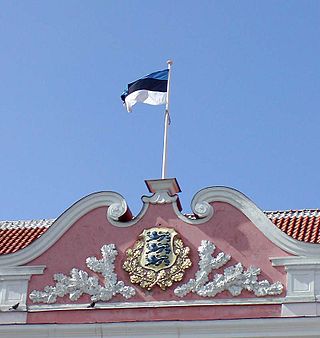
The national symbols of Estonia are flags, coat of arms, icons or cultural expressions that are emblematic, representative or otherwise characteristic of Estonia or Estonian culture.

The heraldic ensigns of the Ministry of Internal Affairs consist of the following elements: large blue shield with a crusader golden eagle, having its head turned to the right, red peak and claws, open wings, holding a silver sword in its right claw; the green olive branch, symbolizing peace and order, replacing the mace from the coat of arms of the country; the small shield, placed on the eagle's chest, having five sectors which symbolize the most important structures of the ministry; at the bottom of the external shield, on a white scarf, the motto of the ministry is written in black: Latin: PRO PATRIA ET ORDINE IURIS, meaning "For the country and for the lawful order". The first sector represents the General Inspectorate of Romanian Police, the second sector includes the heraldic ensigns of the General Inspectorate for Emergency Situations, the third sector contains the ensigns of the General Inspectorate of Border Police, the fourth sector represents the General Inspectorate of Romanian Gendarmerie, the fifth sector represents the Administration, and the sixth sector contains the emblem of the National Archives.
A national coat of arms is a symbol which denotes an independent state in the form of a heraldic achievement. While a national flag is usually used by the population at large and is flown outside and on ships, a national coat of arms is normally considered a symbol of the government or the head of state personally and tends to be used in print, on armorial ware, and as a wall decoration in official buildings. The royal arms of a monarchy, which may be identical to the national arms, are sometimes described as arms of dominion or arms of sovereignty.

The coat of arms of Marseille has witnessed its existence since the 14th century. The current version was adopted in 1883.

The coat of arms that serves as the symbol of the city of Szczecin in West Pomeranian Voivodeship, Poland depicts the head of a red griffin with a yellow (golden) beak wearing a yellow (golden) crown, placed on the blue background.

The coat of arms that served as a symbol of the Augustów Voivodeship (1816–1837), and later, the Augustów Governorate (1837–1867), of the Congress Poland, was divided vertically into two red fields. The left half depicted a knight in a white (silver) armor, sitting on a white (silver) horse with a blue saddle and shabrack, standing on its back hoofs. The knight has a blue shield with a yellow (golden) cross of Lorraine on it, put on his left arm, and hold a sword in his right hand. The right half depicted a black bear facing left and standing on its back legs, with a yellow (golden) collar on its neck.

The coat of arms of Pomerania, also known as the Pomeranian Griffin, is the symbol of Pomerania, a historical region on the southern shore of the Baltic Sea in Central Europe, split between Poland and Germany. It depicts a red griffin with yellow (golden) beak and claws, placed within a white (silver) shield. It originates from the late 12th century.
